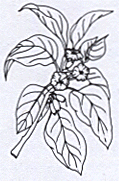Canoe Plants of Ancient Hawai`i Home - Intro - Contents - Bibliography - Links - Credits `Ape - `Awa -`Awapuhi -Hau -Ipu -Kalo -Kamani -Ki -Ko -Kou -Kukui -Mai`a Milo -Niu -Noni -`Ohe -`Ohi`a `Ai -`Olena -Olona -Pia -`Uala -Uhi -`Ulu -Wauke |
Canoe Plants of Ancient Hawai`i Home - Intro - Contents - Bibliography - Links - Credits `Ape - `Awa -`Awapuhi -Hau -Ipu -Kalo -Kamani -Ki -Ko -Kou -Kukui -Mai`a Milo -Niu -Noni -`Ohe -`Ohi`a `Ai -`Olena -Olona -Pia -`Uala -Uhi -`Ulu -Wauke |
 Because of the beauty of its grain and the ease with which it can be cut and carved, true kou is one of the best timber trees in Hawai`i. Cordia subcordata is the botanical name of this plant. Kou is widespread throughout Polynesia and the entire Pacific region, tropical Asia and East Africa, and was probably introduced by seed to Hawai`i in the canoes of the earliest settlers as a useful plant they wished to cultivate. (Recent pollen studies in the Makauwahi Sinkhole at Maha'ulepu on Kaua'i have found that kou was part of the coastal forest on Kaua'i thousands of years before the first Polynesians set foot on the archipelago, but kou was important enough to Polynesians that it was likely introduced as a canoe plant as well.)
Because of the beauty of its grain and the ease with which it can be cut and carved, true kou is one of the best timber trees in Hawai`i. Cordia subcordata is the botanical name of this plant. Kou is widespread throughout Polynesia and the entire Pacific region, tropical Asia and East Africa, and was probably introduced by seed to Hawai`i in the canoes of the earliest settlers as a useful plant they wished to cultivate. (Recent pollen studies in the Makauwahi Sinkhole at Maha'ulepu on Kaua'i have found that kou was part of the coastal forest on Kaua'i thousands of years before the first Polynesians set foot on the archipelago, but kou was important enough to Polynesians that it was likely introduced as a canoe plant as well.)
A member of the Heliotrope family (Boraginaceae), kou is a small to medium-sized erect evergreen tree that grows to a 30-40 foot height at maturity. This plant grows easily and quickly from seed, preferring sunny warm coastal lowlands in the islands' leeward areas. It was cultivated near settlements, and is only occasionally found in the wild forests. Because of its thick wide crown of leaves, kou was a favorite shade tree near home sites. Beneath its cool shelter, the women beat the kapa cloth or would string lei, as they shared the day together.
The straight and erect trunk of kou is pale grey, with grooved and flaky or stringy bark. Within the trunk can be found a heartwood with beautiful colored markings that are reddish dark brown, sometimes with a hint of purple. The sapwood is straw color, with a tint of pink. In the medium soft and durable wood are grain markings, some straight and some of which are wavy with dark and light lines and bands of yellow. The texture is medium fine, and the density is considered medium. The wood is long-lasting, and has little shrinkage. Therefore, large and stable vessels can be made. These were usually carved by the same men who made the wa`a, canoes. These men knew how to season and how to gracefully shape the woods they used for the best and most practical purposes, and how to finish them so that a fine patina was achieved and their beauty would endure. Because of the good workability of kou, it is fashioned into `umeke la`au, containers of wood, crafted with great skill, as well as being aesthetically pleasing. `Umeke kou, food bowls, and specifically poi bowls called `umeke `ai, platters called pa kou, cups and serving dishes of kou were all preferred, because there is no unpleasant taste in the sap that would flavor food. Also made from kou wood were canoes, paddles, back scratchers, calabashes and boxes, fish hook containers and other carved objects, such as images of deities.
Kou leaves are smooth, large and oval, with a pointed end and rounded base. They are alternately arranged and are about 4 inches long. The leaf stem is 1/2 to 3 inches long. The leaves have wavy edges with prominent midrib and veins. In the old days kou leaves were used to make a brown dye that was applied in designs on kapa. It is said that banyan (ficus) fruit was added to kou leaves to make a fine red dye for tapa cloth.
The showy orange flowers of kou have no scent, and are one inch long, 1-2 inches across, with 5-7 lobes. They grow in clusters on short stalks, and are used as a lei flower.
The fruit is nearly round, one inch long, growing in small clusters. The green fruit changes color to yellow and then to black as they dry and become hard. They contain a "stone" with 1-4 seeds.
Kou occurs in ancient legends of Polynesia, one of which suggests that kou was one of the first trees created.
| Canoe Plants of Ancient Hawai`i Home Intro - Contents - Bibliography - Links - Credits `Ape -`Awa -`Awapuhi -Hau -Ipu -Kalo -Kamani -Ki -Ko -Kou - Kukui -Mai`a |